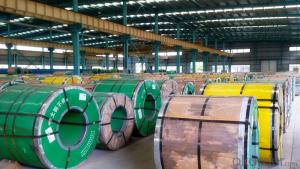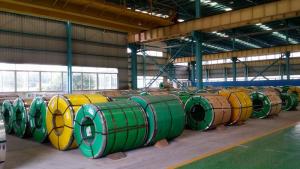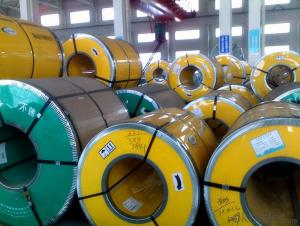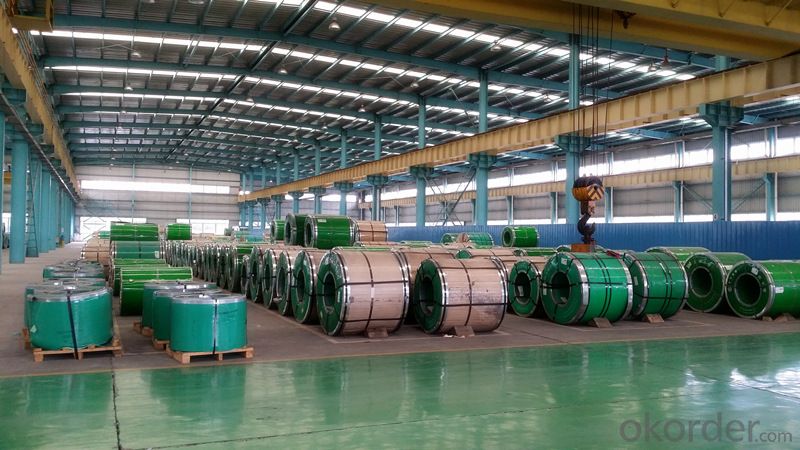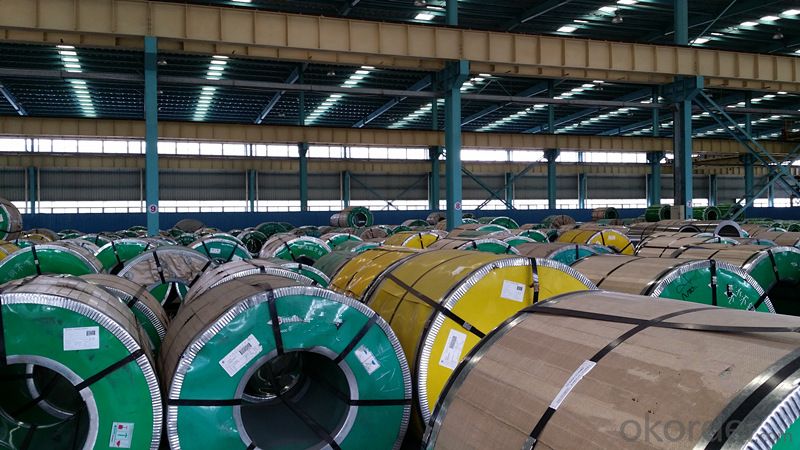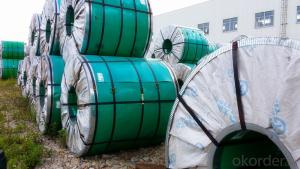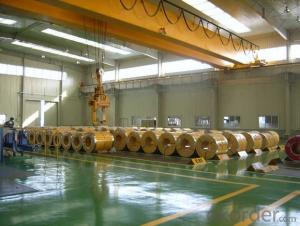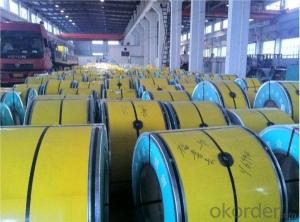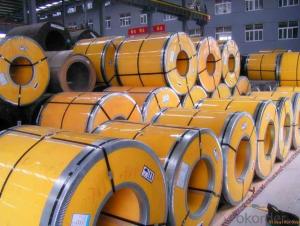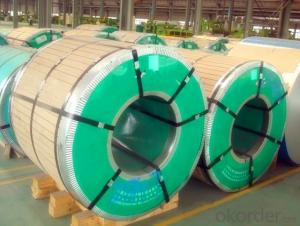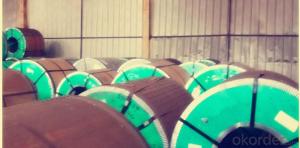Hot Rolled Stainless Steel Coil 304 Grade No.1
- Loading Port:
- China Main Port
- Payment Terms:
- TT OR LC
- Min Order Qty:
- -
- Supply Capability:
- -
OKorder Service Pledge
OKorder Financial Service
You Might Also Like
Type | Hot Rolled Stainless Steel Coil 304 |
Thickness | 3.0mm-4.0mm |
Width | 550mm, 650mm, 1000mm, 1219mm, 1240mm, 1500mm |
Length | according to weight |
Brand name | CNBM |
Standard | ASTM, AISI, DIN, GB, JIS etc |
Material | 304 |
Application | Foodstuff, Gas, metallurgy, biology, electron, chemical, petroleum, boiler, nuclear energy, Medical equipment, fertilizer etc |
Package | Standard export sea-worthy packing |
Delivery time | Within 15 days since getting the deposit or LC origin |
Surface | NO.1 |
Productivity | 20000 tons/month |
Specifications
1.surface:NO.1
2.standard:JIS, AISI, GB
3.width: 0.55m, 0.65m, 1.0m, 1.22m, 1.5m, 2m or requirement
Chemical composition:
(%):C=0.07, Mn=2.00, P=0.045, S=0.030, Si=0.075, Cr=17.5-19.5, Ni=8.0-10.5, N=0.10
Physical Properties
Tensile strength σb (MPa) ≥ 520
the conditions yield strength σ0.2 (MPa) ≥ 205,
elongation δ5 (%) ≥ 40
Reduction of ψ (%) ≥ 50,
hardness: ≤ 187
HB; ≤ 90
HRB; ≤ 200H
- Q: What are stainless steel strips used for?
- Due to their unique properties and versatility, stainless steel strips have a wide range of applications. Various industries, including automotive, construction, aerospace, and manufacturing, commonly utilize them. In the production of kitchen appliances and utensils, stainless steel strips are essential. Their corrosion-resistant nature prevents rust and staining, ensuring a longer lifespan for these products. Additionally, they are used to fabricate sinks, countertops, and backsplashes, which provide a durable and hygienic surface that is easy to clean. Within the automotive industry, stainless steel strips are employed in the manufacturing of exhaust systems, mufflers, and trim components. This is due to their high-temperature resistance and corrosion resistance, which guarantee longevity and performance even in harsh conditions. Construction and architecture also benefit from stainless steel strips. These strips can be found in structural components such as beams, columns, and reinforcement bars. In environments where corrosion or weathering is a concern, the durability and strength of stainless steel make it an ideal choice. The manufacturing industry relies on stainless steel strips for the fabrication of machinery and equipment. Conveyor belts, springs, and fasteners are all made using these strips. The strength, toughness, and resistance to wear and tear of stainless steel make it a reliable choice in these applications. In conclusion, stainless steel strips are essential materials in a wide range of applications. Their corrosion resistance, durability, strength, and aesthetic appeal make them versatile and indispensable in various industries.
- Q: How do stainless steel strips perform in high-humidity environments?
- Stainless steel strips exhibit exceptional resistance to corrosion, making them ideal for use in environments with high levels of humidity. The presence of chromium in stainless steel results in the formation of a protective layer on the surface, preventing any interaction between the metal and moisture or humidity. This protective layer, referred to as the passive film, remains intact even in conditions of high humidity, ensuring that the structural integrity of the stainless steel strip remains unaffected. Additionally, stainless steel boasts a low thermal conductivity, thus preventing the absorption or retention of moisture from the surrounding environment. This characteristic further enhances its ability to perform admirably in high-humidity environments by significantly reducing the risk of moisture accumulation and consequent corrosion. In conclusion, stainless steel strips are an excellent choice for applications in high-humidity environments due to their corrosion-resistant properties and their capacity to endure moisture without compromising their performance or structural integrity.
- Q: Are stainless steel strips suitable for low-temperature applications?
- Yes, stainless steel strips are suitable for low-temperature applications. Stainless steel is known for its excellent resistance to corrosion, high strength, and durability, making it an ideal material for use in low-temperature environments. It retains its mechanical properties at extremely low temperatures and remains resistant to cracking, making it reliable for applications such as cryogenic storage, refrigeration, and freezing equipment.
- Q: Can stainless steel strips be used in the production of aerospace fasteners?
- Indeed, aerospace fasteners can be produced utilizing stainless steel strips. Stainless steel, renowned for its remarkable mechanical characteristics, resistance to corrosion, and superior strength-to-weight ratio, is widely employed in the aerospace sector. The strips can be molded, trimmed, and fashioned into an assortment of fastener elements, including screws, bolts, nuts, and washers. These fasteners play a pivotal role in interconnecting and safeguarding various components of aircraft or spacecraft. Moreover, stainless steel's ability to endure elevated temperatures and hostile surroundings renders it an appropriate option for aerospace purposes.
- Q: What are the different types of stainless steel strips available?
- There are several different types of stainless steel strips available, each with their own unique properties and applications. 1. Austenitic Stainless Steel Strips: This type of stainless steel is the most common and widely used. It has excellent corrosion resistance, good formability, and high ductility. Austenitic stainless steel strips are often used in food processing, chemical, and pharmaceutical industries. 2. Ferritic Stainless Steel Strips: Ferritic stainless steel strips have high resistance to corrosion, but lower ductility and formability compared to austenitic stainless steel. They are commonly used in automotive applications, as well as in appliances and exhaust systems. 3. Martensitic Stainless Steel Strips: Martensitic stainless steel strips are known for their high strength and hardness. They have moderate corrosion resistance and are often used in applications that require wear resistance, such as cutlery, surgical instruments, and industrial equipment. 4. Duplex Stainless Steel Strips: Duplex stainless steel strips combine the best qualities of both austenitic and ferritic stainless steels. They have excellent corrosion resistance, high strength, and good weldability. Duplex stainless steel strips are commonly used in chemical processing, oil and gas industries, and marine environments. 5. Precipitation Hardening Stainless Steel Strips: This type of stainless steel can be hardened through heat treatment, resulting in high strength and excellent corrosion resistance. Precipitation hardening stainless steel strips are used in aerospace applications, as well as in high-performance components and tools. It's important to consider the specific requirements of your application and consult with a stainless steel supplier to determine the best type of stainless steel strip for your needs.
- Q: Can stainless steel strips be used in the construction equipment industry?
- Yes, stainless steel strips can be used in the construction equipment industry. Stainless steel is known for its durability, corrosion resistance, and strength, making it an ideal material for various construction equipment applications. Stainless steel strips can be used for structural components, such as frames, supports, and brackets, as well as for decorative or protective purposes. Additionally, stainless steel's ability to withstand extreme temperatures and harsh environments adds to its suitability for the construction equipment industry.
- Q: What is the maximum thickness available for stainless steel strips?
- The maximum thickness available for stainless steel strips can vary, but it is typically around 6mm to 8mm.
- Q: What is the corrosion resistance of stainless steel strips in saltwater?
- Stainless steel strips have excellent corrosion resistance in saltwater due to their high chromium content, which forms a protective oxide layer on the surface, preventing corrosion and rusting. This makes stainless steel strips a suitable choice for various marine applications.
- Q: Can stainless steel strips be used for architectural balustrades?
- Yes, stainless steel strips can be used for architectural balustrades. Stainless steel is a popular material choice for balustrades in architectural applications due to its durability, strength, and aesthetic appeal. Stainless steel strips can be shaped, bent, and welded to create intricate and stylish balustrade designs. Additionally, stainless steel is resistant to corrosion, making it suitable for both indoor and outdoor use. The smooth and polished surface of stainless steel strips adds a modern and sleek look to architectural balustrades, making them a popular choice in contemporary designs.
- Q: Are stainless steel strips resistant to phosphoric acid?
- Stainless steel strips, in general, exhibit resistance to phosphoric acid. The corrosion-resistant nature of stainless steel stems from the inclusion of chromium and other alloying elements. Phosphoric acid, being a comparatively mild acid, typically does not induce substantial corrosion or harm to stainless steel. Nevertheless, it is crucial to acknowledge that extended exposure to concentrated or high-temperature phosphoric acid may still lead to surface corrosion or pitting on stainless steel. Consequently, it is advisable to minimize contact with phosphoric acid to preserve the longevity and aesthetics of stainless steel strips.
Send your message to us
Hot Rolled Stainless Steel Coil 304 Grade No.1
- Loading Port:
- China Main Port
- Payment Terms:
- TT OR LC
- Min Order Qty:
- -
- Supply Capability:
- -
OKorder Service Pledge
OKorder Financial Service
Similar products
Hot products
Hot Searches
Related keywords
